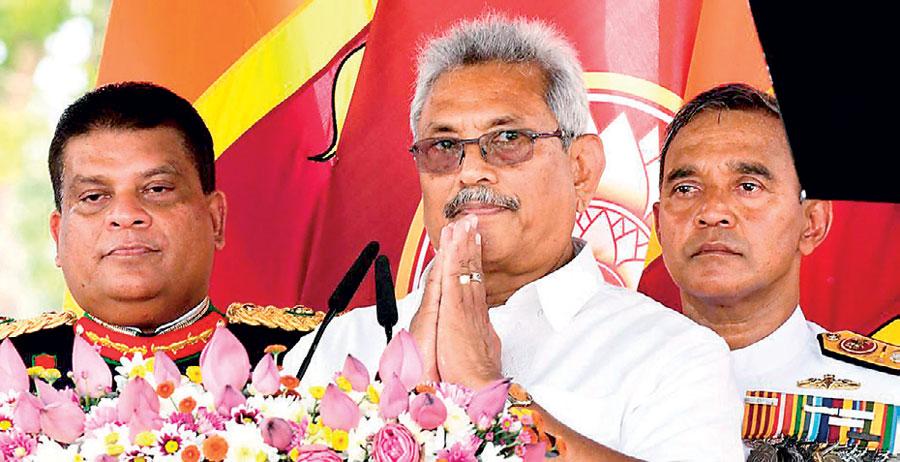Reply To:
Name - Reply Comment

President Gotabaya Rajapakse addressing the public after taking oaths
 In January this year, an iron curtain had descended to end Gotabaya Rajapaksa’s elusive dream to become the seventh president of Sri Lanka. Then several legal battles threatened to put the final full stop to his political ambition to be the president. To many it looked an impossible dream.
In January this year, an iron curtain had descended to end Gotabaya Rajapaksa’s elusive dream to become the seventh president of Sri Lanka. Then several legal battles threatened to put the final full stop to his political ambition to be the president. To many it looked an impossible dream.
Not that Gotabaya was unpopular. He was immensely popular, next to his elder brother Mahinda, in the south. Rajapaksa and his media and legal teams however stuck to their task, undaunted. On November 18, he took 6,924,255 (52.25 percent) votes.
The challenges before him are certainly daunting. Jaffna votes indicate that national reconciliation is a priority. He was quick to recognise this when he said, “I am the President of not only those who voted for me but also those who voted against me and irrespective of which race or religion they belong to. I am deeply committed to serve all the people of Sri Lanka.”
The next challenge is to get competent and credible people with no baggage to run the key economic centres in his government. The mistake the ‘Yahapalana’ folks did should not be repeated. The extravaganza needs to be curtailed.
The Presidential Secretariat has already informed ministry secretaries, chief secretaries and governors’ secretaries that state foreign tours have been suspended until further notice on the orders of President Gotabaya Rajapaksa. He had asked not to close roads when travelling and to reduce his convoy to only to two back up vehicles, also to reduce his staff from 1200 to 200.
Agenda
The new president has made a lot of promises and it is essential that he makes good for the people who voted for him. There is also a general election to be held sooner or later. He has to make sure by then that he has engineered a culture shift. Because once back in power, most leaders start from where they left. Will Gotabaya be able to make a difference? He certainly can if gets the right people onboard.
A country thrives on talent and if Sri Lanka is to produce more high-quality talent, the country’s educational system has to undergo a transformation. Our schools and academic institutions have to meet the demands of our future economy.
In addition to education, greater support for small and medium enterprises (SMEs) will directly improve the livelihoods of the lower middle class. Several governments in Sri Lanka have actively created avenues to support SME investment, including providing tax concessions where possible.
The benefits of economic growth have to be more widely distributed because inclusive growth is the cornerstone of sustainable development. Mainstreaming sustainability considerations in policymaking will, in turn, support inclusiveness.
We need measures to reduce extreme poverty in many of our regions, along with broader development. But much work remains to be done because higher growth is contingent on strong and sustained domestic reforms. Structural weaknesses, such as poor infrastructure, low investment in education, low productivity and huge social deficits unless addressed, will prevent us from reducing our poverty levels.
Important lesson
The important lesson of recent decades is that, although economic growth is vital and necessary, it is not enough to create shared and sustainable prosperity. That requires shifting the focus of development policies to address not only ‘inequalities of income’ but also ‘inequalities of opportunity’.
For sustainable development to succeed, growth must be made more inclusive, by addressing social and environmental deficits. It is essential for the government to launch integrated and well-designed packages of inclusive policies to boost opportunities for productive employment and job security, equitable access to finance and to provide adequate access to basic services, such as education, healthcare, energy and water. There should be no additional indirect taxes passed on to the poor.
Wasteful and unproductive public expenditure has to be curtailed; public institutions have to be more efficient and demand-driven; public enterprises have to be on equal-footing with private enterprises. When it comes to managing our debt burden, the strategy must be to reduce our commercial borrowings and make the debt stock manageable. Tax collection has to be fair and efficient.
Then for years we have lived on a fragile exchange rate. Weak external finances clearly show the vulnerability of our exchange rate. In the current account of our balance of payments, it should be the export potential that should reflect the country’s productive strength.
But, for years our net exports, have shown a big deficit, which is covered by worker remittance. These are surely not signs of economic and social prosperity. All this needs to change now.
Unless the president initiates a clear course of action with targets, nothing will really change in Sri Lanka and we will remain a lower middle income country for another decade.
The country seems to be now firmly glued to the Rajapaksas. For Sri Lanka, this is nothing new because the Sri Lankan voter, unlike in the past, is brutal and unforgiving when a government (strong or weak) fails to deliver. Moreover, time flies and what is past is done and will not be forgotten.
(Dinesh Weerakkody is a thought leader)